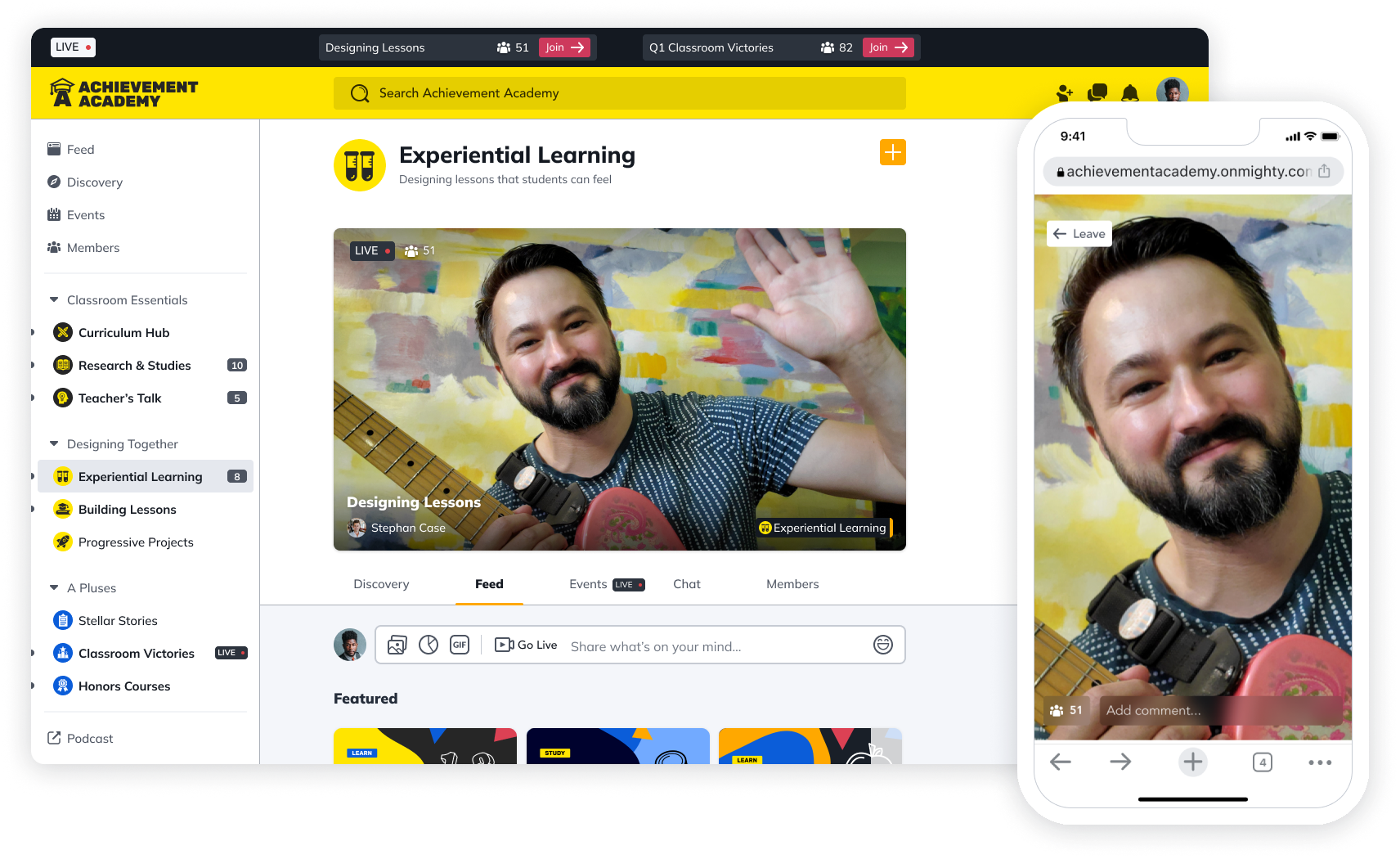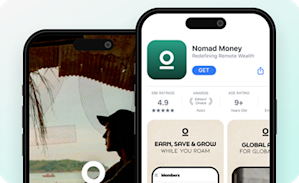Communities & Memberships
What Is a Customer Community? (+Examples)
A customer community is a dedicated space that hosts a relationship between a brand or company and its customers.
Author
Mighty Team
Last Updated
October 15, 2025

One-directional customer relationships are so 2005. The greatest brands of our time don't just talk at their customers, they engage with them and build meaningful connections. And this is where a customer community comes in.
What is a customer community?
A customer community is a dedicated space that hosts a relationship between a brand or company and its customers; it can allow for questions and answers, knowledge exchange, customer education or promotional opportunities, or product support and feedback. This relationship could be built in different ways, for example, through email, a website, social media, or a dedicated online forum.
The important word here is RELATIONSHIP. Good customer communities aren’t just places for brands to throw sales pitches. The old saying is that people want to do business with those they “know, like, and trust,” and that’s what a customer community does best. It creates the space for this trust to grow.

Customer communities can be theoretically understood as digging into what’s called “Social Identity Theory:” when people become members of any social group–including good customer communities–they feel a sense of belonging, purpose, self-worth, and identity.
Here are a few amazing examples of what customer communities–whether free, enterprise customer communities or paid brand communities–can do…
A non-profit onboarded 9,000 national members.
A faith-based community expanded to 470 leaders in 67 countries.
An entrepreneurship org. launched to 5,000 members and recouped their investment in a customer-community app in 2 ½ weeks.
A health-focused launch to 100 high-ticket members added $40,000 in ARR.
One community launched a 13-week add-on course and generated an additional $100k in revenue in 2 months.
One personal finance community generated $130K in five days with their latest course.
One social impact SAAS company mixed a customer-community app with their regular conferences and saw a 70% increase in contributions & engagement.

What a customer community is NOT
Understanding the theoretical foundation for customer communities helps us see why great customer communities are not your email list or even your Facebook group. In order to tap into the benefits of community below, you need to have at least created members who feel like they belong.
With this in mind, here are some of the things a customer community is not:
An email list
The number of social media followers you have
The members of your Facebook group
The amount of likes on your last post
The people calling your customer service line
Your chatbot users
Since we established that the foundation of customer communities is belonging, it’s easy to see why these things aren’t a customer community. They are all interactions with your brand, but they don’t carry a sense of belonging.
The closest thing here is a Facebook group, but even here we find very loose brand attachment and belonging–it’s hard to use Facebook to create the type of dynamic relationship and member-led engagement that grows a real brand community.

Why you should build a customer community
The benefits of a customer community
Access member-led growth
There’a new generation of high-impact businesses built around membership communities. In fact, community is such a powerful business that McKinsey identified it as the ultimate business model for the 2020s: a community flywheel.
We’ve seen the explosion of member-led growth businesses–including customer communities. If paid, they can create incredible recurring revenue opportunities. But the community also puts growth on autopilot.
We’ve talk about community as “a business that grows itself,” because the combination of member-generated content, excitement driven by members, AND AI tools to simplify community management means that it’s easier than ever to build the human connections that drive your business.
It’s the secret that brands like Logo, Apple, and Nike are all leveraging, leading to massive gains. (See the examples below.)
Forget about funnels. There’s nothing like a customer community to grow a brand on autopilot.

Increase brand loyalty
A 2022 study argued that thriving brand communities have such a profound impact on brand loyalty–because the brand community becomes an important part of a member’s identity. In fact, the close connection between social identity and brand loyalty can be developed intentionally–and it plays into perceived value and brand satisfaction.
Transforming customers, subscribers, or followers into members is something you shouldn’t take lightly. Unlike all of those transactional relationships, members belong.
And belonging instead of buying is a fundamental part of building a community flywheel.

Improve CLV
We know that customer lifetime value (CLV) is fed by retention, but only a few brands consistently get it right. In a study, SurveySparrow found that the top brands enjoyed around a 94% retention ratio–even though retention was as low as 4% in some industries.
Although brand loyalty is valuable in its own right, it does lead directly into increasing your customer lifetime value. This is a no-brainer, because retention and connection–again, transforming buyers to members–will grow your CLV like nothing else.

Makes selling a breeze.
One of the things that the study of community flywheels showed is that selling becomes radically easier with a community.
The traditional sales funnel focuses on pushing all of your potential leads through sales sequence, losing more and more until you find the small percentage that will buy.
With a customer community, you don’t do this. Virtually all of your “leads” are always warm, and unless they leave the community, they’ll stay in your ecosystem whether they’re ready to buy yet or not.
The result is an unbelievably rich environment for sales, where you don’t need to rely on pressure or fake deadlines, just keep nurturing and giving value and watch the amazing results when you go to sell something. Many of our communities tell us that they even have members asking for things to buy.
This brings us to…
Get the ultimate feedback
Customer feedback is vital. Yet HubSpot’s research team found that 42% of companies survey their customers or collect feedback!
What if there was a better way to collect feedback than sending out surveys and hoping for a response?
Enter: the customer community. A recent Forbes article collected 50 stats about customer experience. For example, two-thirds of companies are now competing on customer experience. Companies that focus on customer experience outperform their competitors by almost 80%.

Put customer service on autopilot
We’ve highlighted Apple as a cool customer community example below. Apple uses their customer community for customer service, and gamifies the whole thing so that hardcore Apple users show up for free and give answers for free!
It’s an ingenious way to put brand loyalty to work, and lets them harness the sense of belonging that members feel for the brand into something productive–making customer service come alive.
Instead of calling a 1-800 number or waiting for a chatbot, people can get their questions answered in the community. That’s powerful.
Make transformations happen
People buy a product or service because they want something. Usually, that something is a transformation of some sort, whether it's a clean kitchen (i.e. oven cleaner), to lose 10 pounds (ie. running gear), to have the perfect garden (i.e. a gardening magazine), or to spend Saturdays in the backyard with their family (i.e. a BBQ).
But just because someone buys a tent, it doesn't mean they know how to camp. This is where a great customer community comes in. If you can go beyond the transaction, and help your customers actually succeed with your product or service, you will have raving fans who’ll tell their friends about you. In short, a customer community isn’t simply to sell more. It’s to help your customers succeed.
There’s more! A thriving customer community will also give you valuable feedback on your products and services, feedback that you might otherwise have to pay to get.
For these reasons and more, building a customer community makes a ton of sense. So what are you waiting for?
Harness real engagement
If your idea of customer engagement is hoping your social media posts get 15 likes, you’re in the wrong ballgame. A customer community can create real customer engagement, real relationships with customers–remember, we said that the goal is for a customer to be a member.
It’s amazing when you can get off the content treadmill of social media and build real engagement that people love.

6 awesome examples of customer communities
1. Duolingo
Duolingo is the app that made language learning fun, easy, and pretty much free (freemium)! And behind the scenes, Duolingo has a dedicated volunteer community that devotes itself to answering user language questions and making the app better.
Sold on the idea that EVERYONE should have access to language learning, these passionate polyglots even volunteer their time to incorporate new languages and modules onto the platform!

2. Lego
Lego is a multibillion-dollar brand, known to kids for the amazing building potential and known by parents as little landmines that hurt when you step on them.
Just kidding!
Actually, Lego is loved around the world by kids and adults alike, and a collection of devoted builders share ideas on the Lego customer community. Members can even vote on which fan builds should get the stamp of approval to become authentic Lego kits!
3. Peloton
Peloton rose to prominence during the pandemic when we were all trying to exercise in our living rooms. They created a powerful customer community around exercise. Users can swap scores, video chat during their sessions, and encourage each other on the Peloton Facebook group.

4. Adobe
Adobe products are dedicated to creating: photos, videos, music, and more. They’re industry standards. But ask anyone who’s ever used an Adobe product, and they’ll tell you that they’re not easy to learn.
The Adobe customer community provides a space for people to share questions and answers, as well as tips for making the most out of the software. Their slogan, "Come for help, be inspired," pretty much sums their approach, which starts with helping customers figure out their programs, and takes them on a journey towards mastering their art.

5. Apple
Apple has built a thriving customer community that doubles as a customer support platform. They’ve even gamified the experience so that contributors get more points and are allowed more community moderation features as they move up levels. Users who get to the top levels also get access to an exclusive community.
And yes, if you’re thinking it, gamifying your customer service so that customers want to spend time providing each other with support is a pretty brilliant use of a customer community.
6. Shopify
For a great customer community in action, look no further than Shopify. Since Shopify helps their customers build stores to sell their stuff, the Shopify community is dedicated to providing training and knowledge-building, answering FAQs, and even hosting live events.
Ready to build your own customer community?
Whether your customer community will be a free, enterprise community or a paid membership to bring in some extra revenue, come build with Mighty!
Mighty brings together courses, content, community, and commerce. Our flexible Spaces let you build a customer community like no other, mixing in discussions, chat & messaging, livestreaming, live events, and courses (if you want). You can choose the features you want (and turn the rest off).
Mighty gives you a suite of member-management tools to make it easy to run the community, and our AI community-engine–Mighty Co-Host™–automates things like member profiles, landing pages, course outlines, and even discussion questions. It’s radically easier to create a thriving customer community with only a few hours of work a week.
And with Mighty Pro, you get G2’s top-ranked community software on your own branded app–that’s your app in the App Store and Google Play Store.
Book a call today and we’ll show you what we could build together.
Ready to start building your community?
Start a free 14-day trial to explore Mighty—no credit card required.
More like this
Join Mighty Community
Learn the principles of Community Design™ (and see them in action) alongside thousands of creators and entrepreneurs. It's free to join!

Online Courses
Creating a Course
Teaching a Course
Course Platforms
Selling a Course
Communities & Memberships
Community Platforms
Managing a Community
Building a Community
Growing a Community
Monetizing a Community
Content Creation
Creators & Entrepreneurs
Monetization
Content Creation
Starting a Business
Website Builders
Creating & Managing a Website
Events
Event Platforms
Hosting & Marketing Events
Branded Apps
Creating a Mobile App
Coaching Apps
Community Apps
Coaching
Mastermind Groups
Starting a Coaching Business
Coaching Platforms
Filter by Category
Online Courses
Communities & Memberships
Creators & Entrepreneurs
Events
Branded Apps
Coaching
Build a $1 Million Community
This free masterclass went viral—sign up to learn why.

























